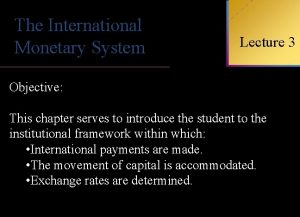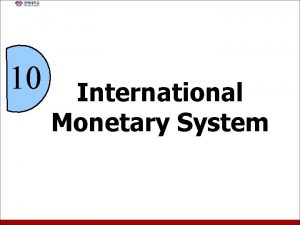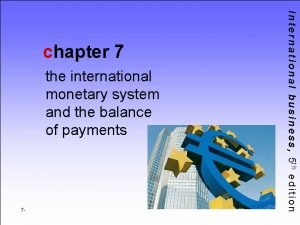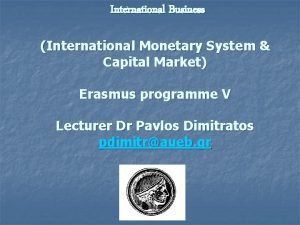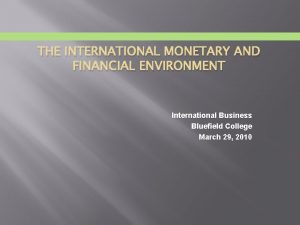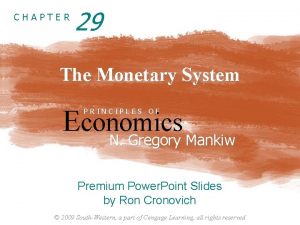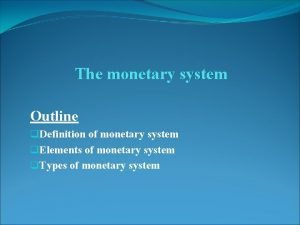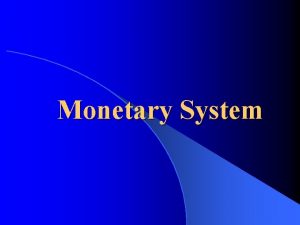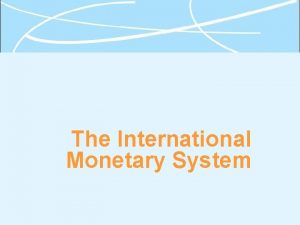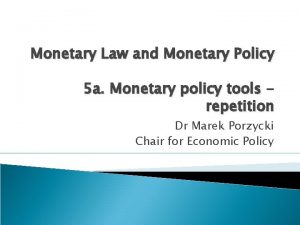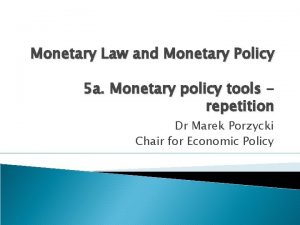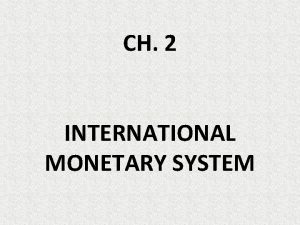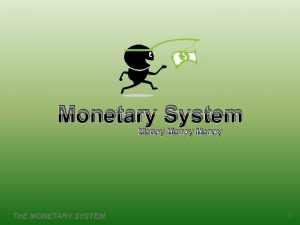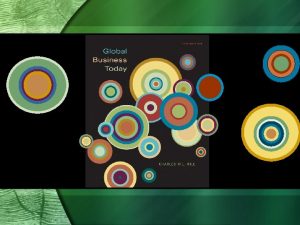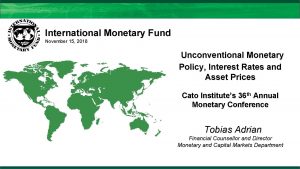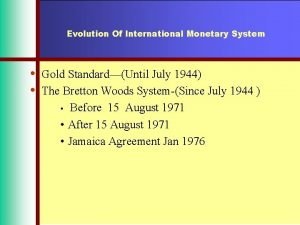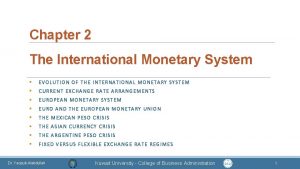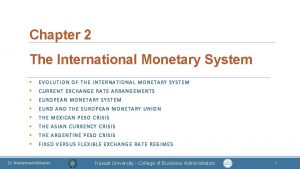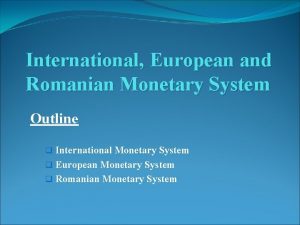The International Monetary System Outline 2 1 Evolution



























- Slides: 27

The International Monetary System

Outline � � � 2 -1 Evolution of the International Monetary System Current Exchange Rate Arrangements European Monetary System Euro and the European Monetary Union Fixed versus Flexible Exchange Rate Regimes

Evolution of the International Monetary System � Bimetallism: Before 1875 � Classical Gold Standard: 1875 -1914 � Interwar Period: 1915 -1944 � Bretton Woods System: 1945 -1972 � The Flexible Exchange Rate Regime: 1973 Present 2 -2

Bimetallism: Before 1875 �A “double standard” in the sense that both gold and silver were used as money. � Some countries were on the gold standard, some on the silver standard, some on both. � Both gold and silver were used as international means of payment and the exchange rates among currencies were determined by either their gold or silver contents. � Gresham’s Law implied that it would be the least valuable metal that would tend to circulate. 2 -3

Classical Gold Standard: 1875 -1914 � During this period in most major countries: ◦ Gold alone was assured of unrestricted coinage ◦ There was two-way convertibility between gold and national currencies at a stable ratio. ◦ Gold could be freely exported or imported. � The exchange rate between two country’s currencies would be determined by their relative gold contents. 2 -4

Classical Gold Standard: 1875 -1914 For example, if the dollar is pegged to gold at U. S. $30 = 1 ounce of gold, and the British pound is pegged to gold at £ 6 = 1 ounce of gold, it must be the case that the exchange rate is determined by the relative gold contents: $30 = £ 6 $5 = £ 1 2 -5

Classical Gold Standard: 1875 -1914 � Highly stable exchange rates under the classical gold standard provided an environment that was conducive to international trade and investment. � Misalignment of exchange rates and international imbalances of payment were automatically corrected by the price-specie- flow mechanism. 2 -6

Price-Specie-Flow Mechanism � Suppose Great Britain exported more to France than France imported from Great Britain. � This cannot persist under a gold standard. ◦ Net export of goods from Great Britain to France will be accompanied by a net flow of gold from France to Great Britain. ◦ This flow of gold will lead to a lower price level in France and, at the same time, a higher price level in Britain. � The resultant change in relative price levels will slow exports from Great Britain and encourage exports from France. 2 -7

Classical Gold Standard: 1875 -1914 � There are shortcomings: ◦ The supply of newly minted gold is so restricted that the growth of world trade and investment can be hampered for the lack of sufficient monetary reserves. ◦ Even if the world returned to a gold standard, any national government could abandon the standard. 2 -8

Interwar Period: 1915 -1944 � Exchange rates fluctuated as countries widely used “predatory” depreciations of their currencies as a means of gaining advantage in the world export market. � Attempts were made to restore the gold standard, but participants lacked the political will to “follow the rules of the game”. � The result for international trade and investment was profoundly detrimental. 2 -9

Bretton Woods System: 1945 -1972 � Named for a 1944 meeting of 44 nations at Bretton Woods, New Hampshire. � The purpose was to design a postwar international monetary system. � The goal was exchange rate stability without the gold standard. � The result was the creation of the IMF and the World Bank. 2 -10

Bretton Woods System: 1945 -1972 � Under the Bretton Woods system, the U. S. dollar was pegged to gold at $35 per ounce and other currencies were pegged to the U. S. dollar. � Each country was responsible for maintaining its exchange rate within ± 1% of the adopted par value by buying or selling foreign reserves as necessary. � The Bretton Woods system was a dollar-based gold exchange standard. 2 -11

Bretton Woods System: 1945 -1972 German mark British pound r a P lue Va Par Value French franc Va Pa lue r U. S. dollar Pegged at $35/oz. Gold 2 -12

The Flexible Exchange Rate Regime: 1973 -Present � Flexible exchange rates were declared acceptable to the IMF members. ◦ Central banks were allowed to intervene in the exchange rate markets to iron out unwarranted volatilities. � Gold was abandoned as an international reserve asset. � Non-oil-exporting countries and lessdeveloped countries were given greater access to IMF funds. 2 -13

Current Exchange Rate Arrangements � Free Float ◦ The largest number of countries, about 48, allow market forces to determine their currency’s value. � Managed Float ◦ About 25 countries combine government intervention with market forces to set exchange rates. � Pegged to another currency ◦ Such as the U. S. dollar or euro (through franc or mark). � No national currency ◦ Some countries do not bother printing their own, they just use the U. S. dollar. For example, Ecuador, Panama, and El Salvador have dollarized. 2 -14

European Monetary System � Eleven European countries maintain exchange rates among their currencies within narrow bands, and jointly float against outside currencies. � Objectives: ◦ To establish a zone of monetary stability in Europe. ◦ To coordinate exchange rate policies vis-à-vis non. European currencies. ◦ To pave the way for the European Monetary Union. 2 -15

What Is the Euro? � The euro is the single currency of the European Monetary Union which was adopted by 11 Member States on 1 January 1999. � These original member states were: Belgium, Germany, Spain, France, Ireland, Italy, Luxemburg, Finland, Austria, Portugal and the Netherlands. 2 -16

EURO CONVERSION RATES 1 Euro is Equal to: 2 -17 40. 3399 BEF Belgian franc 1. 95583 DEM German mark 166. 386 ESP Spanish peseta 6. 55957 FRF French franc . 787564 IEP Irish punt 1936. 27 ITL Italian lira 40. 3399 LUF Luxembourg franc 2. 20371 NLG Dutch gilder 13. 7603 ATS Austrian schilling 200. 482 PTE Portuguese escudo 5. 94573 FIM Finnish markka

What is the official sign of the euro? � The sign for the new single currency looks like an “E” with two clearly marked, horizontal parallel lines across it. � It € was inspired by the Greek letter epsilon, in reference to the cradle of European civilization and to the first letter of the word 'Europe'. 2 -18

What are the different denominations of the euro notes and coins ? � There are be 7 euro notes and 8 euro coins. � The notes are: € 500, € 200, € 100, € 50, € 20, € 10, and € 5. � The coins will be: 2 euro, 1 euro, 50 euro cent, 20 euro cent, 10, euro cent, 5 euro cent, 2 euro cent, and 1 euro cent. � The euro itself is divided into 100 cents, just like the U. S. dollar. 2 -19

Fixed versus Flexible Exchange Rate Regimes � Arguments in favor of flexible exchange rates: � Arguments against flexible exchange rates: ◦ Easier external adjustments. ◦ National policy autonomy. ◦ Exchange rate uncertainty may hamper international trade. ◦ No safeguards to prevent crises. 2 -20

Fixed versus Flexible Exchange Rate Regimes � Suppose the exchange rate is $1. 40/£ today. � In the next slide, we see that demand for British pounds far exceed supply at this exchange rate. � The U. S. experiences trade deficits. 2 -21

Dollar price per £ (exchange rate) Fixed versus Flexible Exchange Rate Regimes Supply (S) Demand (D) $1. 40 Trade deficit S 2 -22 D Q of £

Flexible Exchange Rate Regimes � Under a flexible exchange rate regime, the dollar will simply depreciate to $1. 60/£, the price at which supply equals demand the trade deficit disappears. 2 -23

Dollar price per £ (exchange rate) Fixed versus Flexible Exchange Rate Regimes $1. 60 $1. 40 Supply (S) Demand (D) Dollar depreciates (flexible regime) Demand (D*) D = S 2 -24 Q of £

Fixed versus Flexible Exchange Rate Regimes � Instead, suppose the exchange rate is “fixed” at $1. 40/£, and thus the imbalance between supply and demand cannot be eliminated by a price change. � The government would have to shift the demand curve from D to D* ◦ In this example this corresponds to contractionary monetary and fiscal policies. 2 -25

Dollar price per £ (exchange rate) Fixed versus Flexible Exchange Rate Regimes Supply (S) Contractionary policies (fixed regime) Demand (D) $1. 40 Demand (D*) D* = S 2 -26 Q of £
 International monetary system
International monetary system Objectives of international monetary system
Objectives of international monetary system International monetary system
International monetary system International monetary system
International monetary system International monetary fund apush
International monetary fund apush International monetary and financial environment
International monetary and financial environment International monetary and financial environment
International monetary and financial environment International monetary fund
International monetary fund International monetary fund
International monetary fund Chapter 29 the monetary system
Chapter 29 the monetary system Monetary system definition
Monetary system definition Quotation sandwich examples
Quotation sandwich examples Evolution of global marketing
Evolution of global marketing International business transactions outline
International business transactions outline Place value chart of indian system and international system
Place value chart of indian system and international system Hát kết hợp bộ gõ cơ thể
Hát kết hợp bộ gõ cơ thể Lp html
Lp html Bổ thể
Bổ thể Tỉ lệ cơ thể trẻ em
Tỉ lệ cơ thể trẻ em Chó sói
Chó sói Tư thế worm breton là gì
Tư thế worm breton là gì Hát lên người ơi alleluia
Hát lên người ơi alleluia Các môn thể thao bắt đầu bằng tiếng chạy
Các môn thể thao bắt đầu bằng tiếng chạy Thế nào là hệ số cao nhất
Thế nào là hệ số cao nhất Các châu lục và đại dương trên thế giới
Các châu lục và đại dương trên thế giới Cong thức tính động năng
Cong thức tính động năng Trời xanh đây là của chúng ta thể thơ
Trời xanh đây là của chúng ta thể thơ Mật thư anh em như thể tay chân
Mật thư anh em như thể tay chân
